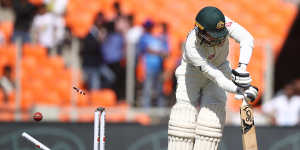Smith,who has one or two acts of questionable Australianness on his CV,said he was “shocked by some of the comments” Hayden made. It was a reaction,from an acting captain,that might have been deemed un-Australian itself (thin-skinned,can’t you take a joke,champ?) until it was eclipsed at the fourth Test match in Ahmedabad by our other national leader.
Just when we were wondering what an un-Australian act is or isn’t,Anthony Albanese came into the Narendra Modi Stadium to lift a stiff right hand to the crowd from a high platform,rode around the field (still waving) in a motorised shoe,and stood arm-in-arm with the team to sing the national anthem. Isn’t that what politicians do in countries like Russia and their demagogue fellow-travellers? Then he left before lunch,presumably to beat the traffic,which is very Sydney but not very Australian. He redeemed himself by not going in at No.5 in the order and batting sensibly. That would be un-Australian and deserving of criticism.
But back to serious cricket issues:the best things the Australians have done on this curious tour of India have been their least Australian. Playing three spin bowlers delivered success.

Todd Murphy has been excellent in India.AP
Todd Murphy prospered in an un-Australian way,bowling finger spin and wearing glasses on the field – the most un-Australian Test player we have produced since Dirk Wellham. When their batters stopped complaining about pitch conspiracies and played to the conditions,they have not only countered but dominated the Indian bowling. Usman Khawaja,who has contended with the “un-Australian” word throughout his career,has been their best,batting with easy grace,a ready smile and epic patience. Not at all Australian qualities. And all without having a drink.
Likewise,India have put Australia on the back foot when playing an unIndian style of cricket. Indian cricket’s traditional M.O. is using the bat like a mortar and the pitch like a pestle,grinding their opponent to powder. But this Indian team retained the Border-Gavaskar Trophy without scoring any runs. Their best batting came from their tailenders,showing some good old grit and true-blue Gallipoli spirit. True,India’s spin bowling has been Indian,but they have also fielded the most effective pace bowlers. When these two teams play the World Test Championship final at The Oval in a couple of months and the best paceman of the lot,Jasprit Bumrah,is on deck again,India’s strength will lie in their offensively un-Indian new-ball attack.
It’s stating the obvious that claims of proprietary ownership of national characteristics on the cricket field are a load of,I don’t know,what’s the Australian word for bullcrap? In this appealing year of Test cricket,cliches about national “personality” are embarrassingly out of date.
Ways of playing Test cricket have a fresh mobility and adaptation. England have set the tone,burning out fuses in old brains with an approach to the five-day game that is the most un-English innovation since chicken tikka masala. As Australia’s tour of India comes to a close,minds will turn to how they can counter this offensively un-English English team.
If the World Test Championship points system was calculated to put the best two teams on the field,England would be the first qualifier. Of 12 Test matches since Ben Stokes and Brendan McCullum took over as captain and coach,they have won 10,scoring at an unprecedented 4.1 runs per over and taking the game on as if they had a round of golf booked for day four. The two matches they have lost were through an excess of daring. They have beaten New Zealand four times out of five,and the one they lost could have been a tie if not for some Kiwi-friendly umpiring at the end.

Peter Handscomb loses his off stump on day one.Getty
Considering the Stokes-McCullum heritage,this might be described as New Zealand beating New Zealand,except that England’s Bazball is as un-New Zealand as it is un-English. It has been – and there is no English word for this – exhilarating.
To get caught up worrying about what constitutes an Australian or un-Australian approach is not only obsolete but it will surely lead to defeat (and is there anything more un-Australian than that?). Any team fretting about whether it is truly displaying national characteristics will find itself in a stereotypical rut. This happened to Australia not long ago. A new regime in 2013 came in with a clear mission statement to play a more “Australian” style of cricket. That vision equated to winning and not much else,and by 2018 it led to losing and quite a bit else.
Best of all would be if Australia went to the Ashes equipped with the confidence to be as un-Australian as they dare. As un-Australian as England are un-English. As un-Australian as they have been when at their best in India,dropping their old insecurities about what they should look like and who they have to please,or what models from the past they have to live up to. This may confront those who think there is only one way of being un-Australian,and back in their day,maybe there was. But in 2023,success is going to those who are un and free.
Sports news,results and expert commentary..